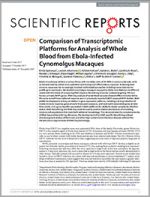
nCounter® NHP Immunology Panel
Helping Your Research
Non-Human Primate (NHP) research is critical to provide insight into the functionality of drugs and vaccines in development. Studies with NHPs are costly and produce a plethora of samples: extracting the maximal biological information out of a given sample in a cost-effective and robust manner becomes key. NanoString’s nCounter barcoding technology provides an ideal solution; you can directly quantify hundreds of transcripts from multiple sample types with minimal hands-on time, and the data is very reproducible.

Comparison of Transcriptomic Platforms for Analysis of Whole Blood from Ebola-Infected Cynomolgus Macaques

Panel Selection Tool
Find the gene expression panel for your research with Panel Pro
Find Your PanelProduct Information
Functional annotations for 18 immune-related signaling pathways were assigned across all genes in the NHP Immunology panel, allowing for a comprehensive and functional view of the NHP immune response.

Publications
Spatial profiling of the placental chorioamniotic membranes reveals upregulation of immune checkpoint proteins during Group B Streptococcus infection in a nonhuman primate model
Background: Preterm birth is a leading cause of neonatal mortality, which is often complicated by intrauterine infection and inflammation. We have established a nonhuman primate model of Group B Streptococcus (GBS, Streptococcus agalactiae) infection-associated preterm birth.
Host response transcriptomic analysis of Crimean-Congo hemorrhagic fever pathogenesis in the cynomolgus macaque model
Crimean-Congo hemorrhagic fever virus (CCHFV) is a highly pathogenic tick-borne RNA virus prevalent in Asia, Europe, and Africa, and can cause a hemorrhagic disease (CCHF) in humans with mortality rates as high as 60%. A general lack of both effective medical countermeasures and a comprehensive understanding of disease pathogenesis is partly driven by an historical lack of viable CCHF animal models.
Bundibugyo ebolavirus Survival Is Associated with Early Activation of Adaptive Immunity and Reduced Myeloid-Derived Suppressor Cell Signaling
Ebolaviruses Bundibugyo virus (BDBV) and Ebola virus (EBOV) cause fatal hemorrhagic disease in humans and nonhuman primates. While the host response to EBOV is well characterized, less is known about BDBV infection.
Request a Quote
Contact our helpful experts and we’ll be in touch soon.

